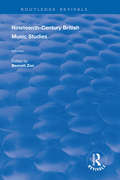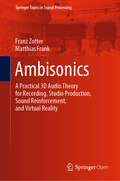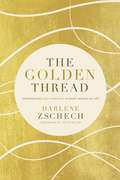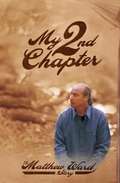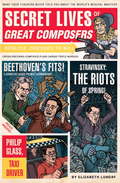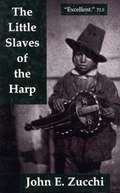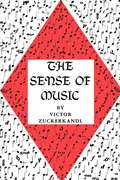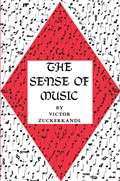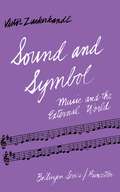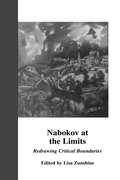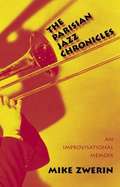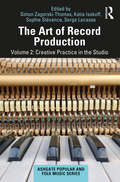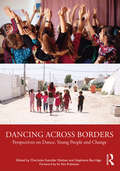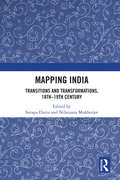- Table View
- List View
Nineteenth-Century British Music Studies: Volume 1 (Routledge Revivals)
by Bennett ZonOriginally published in 1999, this volume of essays arises from the first biennial Music in Nineteenth-Century Britain conference, held at the University of hull in July 1997. Like the conference, this book seeks to expand and reassess our current knowledge of musical life in Britain during the nineteenth century, as well as to challenge the preconceptions of earlier attitudes and scholarship. This volume covers a cohesive range of subjects and materials intended not only as a revision of past views and scholarship, but also as a tool for further research. It provides a vigorous reconsideration of the musical activity of the period.
Ambisonics: A Practical 3D Audio Theory for Recording, Studio Production, Sound Reinforcement, and Virtual Reality (Springer Topics in Signal Processing #19)
by Franz Zotter Matthias FrankThis open access book provides a concise explanation of the fundamentals and background of the surround sound recording and playback technology Ambisonics. It equips readers with the psychoacoustical, signal processing, acoustical, and mathematical knowledge needed to understand the inner workings of modern processing utilities, special equipment for recording, manipulation, and reproduction in the higher-order Ambisonic format. The book comes with various practical examples based on free software tools and open scientific data for reproducible research.The book’s introductory section offers a perspective on Ambisonics spanning from the origins of coincident recordings in the 1930s to the Ambisonic concepts of the 1970s, as well as classical ways of applying Ambisonics in first-order coincident sound scene recording and reproduction that have been practiced since the 1980s. As, from time to time, the underlying mathematics become quite involved, but should be comprehensive without sacrificing readability, the book includes an extensive mathematical appendix. The book offers readers a deeper understanding of Ambisonic technologies, and will especially benefit scientists, audio-system and audio-recording engineers.In the advanced sections of the book, fundamentals and modern techniques as higher-order Ambisonic decoding, 3D audio effects, and higher-order recording are explained. Those techniques are shown to be suitable to supply audience areas ranging from studio-sized to hundreds of listeners, or headphone-based playback, regardless whether it is live, interactive, or studio-produced 3D audio material.
The Golden Thread: Experiencing God’s Presence in Every Season of Life
by Darlene Zschech Joyce Meyer“I know your faith will be lifted and increased with this new treasure.”~Chris TomlinDo you feel like you are barely holding on?Let the golden thread of God's presence be the calm on the other side of chaos.It could be that He is weaving a brilliant new beginning in the middle of your mess.Join beloved worship leader Darlene Zschech as she traces God’s goodness through her recent transitions—moving to a new city, starting a church. The songwriter of “Shout to The Lord” urges us to maintain joy in the middle of it all.Rather than seeing her many life changes as a zigzag of unrelated events, Darlene and her family have learned to trace God’s goodness through every crisis—even as she faced the battle for her life, cancer.Your heart will be encouraged, and your faith will soar right along with Darlene’s.
My 2nd Chapter: The Matthew Ward Story
by Darlene ZschedhHow one family's tragedy ultimately revolutionized contemporary Christian music. Known for such classics as "Easter Song," the Second Chapter of Acts was one of the major music groups in the forefront of the Jesus movement. But what happened, in the wake of personal tragedy, to bring together a brother and his two sisters to sing so boldly for their Lord? And what was life really like for a major contemporary Christian band in those early days? In My Second Chapter, Matthew Ward tells his part of the storyfull of intriguing and humorous behind-the-scenes anecdotes and observations: growing up in a large family...orphaned at age twelve...finding the Lord in the California Jesus movement... becoming a music star...traveling the world...battling cancer...raising his own family ... and much more all revealing God's faithfulness in every circumstance. Join Matthew on his amazing personal journey from tragedy to dynamic faith that helped set contemporary Christian music on fire. And discover how God chooses whom he will to accomplish great and mighty acts.From the Trade Paperback edition.
Secret Lives of Great Composers
by Mario Zucca Elizabeth LundayTrue tales of murder, riots, heartbreak, and great music. With outrageous anecdotes about everyone from Gioachino Rossini (draft-dodging womanizer) to Johann Sebastian Bach (jailbird) to Richard Wagner (alleged cross-dresser), Secret Lives of Great Composers recounts the seamy, steamy, and gritty history behind the great masters of international music. You'll learn that Edward Elgar dabbled with explosives; that John Cage was obsessed with fungus; that Berlioz plotted murder; and that Giacomo Puccini stole his church's organ pipes and sold them as scrap metal so he could buy cigarettes. This is one music history lesson you'll never forget!
The Little Slaves of the Harp: Italian Child Street Musicians in Nineteenth-Century Paris, London, and New York (McGill-Queen's Studies in Ethnic History #13)
by John E. ZucchiDuring the nineteenth century child musicians could be seen performing in the streets of cities across Europe and North America. Although they came from a number of countries, Italians were most associated with street music. In The Little Slaves of the Harp John Zucchi tells the story of the thousands of Italian children who were indentured to padrone and then uprooted from their villages in central and southern Italy and taken to Paris, London, and New York to perform as barrel-organists, harpists, violinists, fifers, pipers, and animal exhibitors.
The Sense of Music
by Victor ZuckerkandlThis book is addressed to the listener whose enjoyment of music is filled with questions and whose curiosity makes him eager to grasp the sense of music, despite a lack of theoretical training. Unlike the usual listener's guide, which begins with a discussion of the elementary materials of music, this book starts with the elementary experiences of listening.
The Sense of Music
by Victor ZuckerkandlThis book is addressed to the listener whose enjoyment of music is filled with questions and whose curiosity makes him eager to grasp the sense of music, despite a lack of theoretical training. Unlike the usual listener's guide, which begins with a discussion of the elementary materials of music, this book starts with the elementary experiences of listening.
Sound and Symbol, Volume 1: Music and the External World (Bollingen Series (General) #655)
by Victor ZuckerkandlAn approach to music as an instrument of philosophical inquiry, seeking not so much a philosophy of music as a philosophy through music.
Nabokov at the Limits: Redrawing Critical Boundaries (Border Crossings)
by Lisa ZunshineThe eleven contributors to this volume investigate the connections between Nabokov's output and the fields of painting, music, and ballet.
The Parisian Jazz Chronicles: An Improvisational Memoir
by Mike ZwerinThis book is built around a structure that treats such subjects of my music column in the International Herald Tribune as Dexter Gordon, Freddy Heineken, Miles Davis, Bob Dylan, Chet Baker, and Melvin Van Peebles as though they were the written notes in big band arrangements.
Will You Miss Me When I'm Gone: The Carter Family and their Legacy in American Music
by Mark Zwonitzer Charles HirshbergThe Art of Record Production: Creative Practice in the Studio
The playback of recordings is the primary means of experiencing music in contemporary society, and in recent years 'classical' musicologists and popular music theorists have begun to examine the ways in which the production of recordings affects not just the sound of the final product but also musical aesthetics more generally. Record production can, indeed, be treated as part of the creative process of composition. At the same time, training in the use of these forms of technology has moved from an apprentice-based system into university education. Musical education and music research are thus intersecting to produce a new academic field: the history and analysis of the production of recorded music. This book is designed as a general introductory reader, a text book for undergraduate degree courses studying the creative processes involved in the production of recorded music. The aim is to introduce students to the variety of approaches and methodologies that are currently being employed by scholars in this field. The book is divided into three sections covering historical approaches, theoretical approaches and case studies and practice. There are also three interludes of commentary on the academic contributions from leading record producers and other industry professionals. This collection gives students and scholars a broad overview of the way in which academics from the analytical and practice-based areas of the university system can be brought together with industry professionals to explore the ways in which this new academic field should progress.
Dancing Across Borders: Perspectives on Dance, Young People and Change
Dancing Across Borders presents formal and non-formal settings of dance education where initiatives in different countries transcend borders: cultural and national borders, subject borders, professional borders and socio-economic borders. It includes chapters featuring different theoretical perspectives on dance and cultural diversity, alongside case narratives that show these perspectives in a specific cultural setting. In this way, each section charts the processes, change and transformation in the lives of young people through dance. Key themes include how student learning is enhanced by cultural diversity, experiential teaching and learning involving social, cross-cultural and personal dimensions. This conceptually aligns with the current UNESCO protocols that accent empathy, creativity, cooperation, collaboration alongside skills- and knowledge-based learning in an endeavour to create civic mindedness and a more harmonious world. This volume is an invaluable resource for teachers, policy makers, artists and scholars interested in pedagogy, choreography, community dance practice, social and cultural studies, aesthetics and interdisciplinary arts. By understanding the impact of these cross-border collaborative initiatives, readers can better understand, promote and create new ways of thinking and working in the field of dance education for the benefit of new generations.
Mapping India: Transitions and Transformations, 18th–19th Century
This book presents an alternate history of colonial India in the 18th and the 19th centuries. It traces the transitions and transformations during this period through art, literature, music, theatre, satire, textiles, regime changes, personal histories and migration. The essays in the volume examine historical events and movements which questioned the traditional parameters of identity and forged a new direction for the people and the nation. Viewing the age through diverse disciplinary angles, the book also reflects on the various reimaginings of India at the time. This volume will be of interest to academics and researchers of modern Indian history, cultural studies and literature. It will also appeal to scholars interested in the anthropological, sociological and psychological contexts of imperialism.
